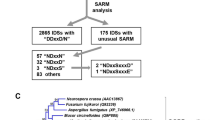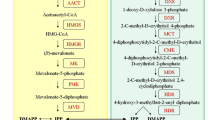Abstract
Three isoprene synthase (IspS) cDNA clones have been isolated from tropical trees (Ficus septica, F. virgata, and Casuarina equisetifolia), and their enzyme properties have been compared with those of Populus alba IspS. Phylogenetic analysis of the deduced amino acid sequences with known monoterpene synthase resolved IspS from F. septica and F. virgata and other IspSs in a clade together with TPS-b clade I, whereas IspS from C. equisetifolia was within another clade, sister to TPS-b clade II. The optimum reaction temperature was 40 °C for the IspSs isolated from the tropical trees, and 45 °C for P. alba IspS. The optimum pH of the IspSs from the tropical trees peaked between pH 8 and pH10 contrasting with the rather broad optimum pH (7.5–10.5) of P. alba IspS. IspSs from F. septica and F. virgata were activated solely by Mg2+, whereas IspS from C. equisetifolia was dependent more on Mn2+ than on Mg2+. Michaelis constant (Km) values of IspSs from tropical trees were lower than that of P. alba IspS. Analysis of inter fragment interaction energy of IspS-substrate complex model and crystal structure of bornyl diphosphate synthase (1N20) found that the coordination geometry of amino acids with higher attraction force is similar at the active site of C. equisetifolia IspS and bornyl diphosphate synthase. These observations suggest the occurrence of another group of IspSs in TPS-b subfamily and extend the knowledge on biochemical regulatory mechanism of isoprene emission from tropical trees.







Similar content being viewed by others
References
Aaron JA, Christianson DW (2010) Trinuclear metal clusters in catalysis by terpenoid synthases. Pure Appl Chem 82:1585–1597
Affek HP, Yakir D (2002) Protection by isoprene against singlet oxygen in leaves. Plant Physiol 129:269–277
Basyuni M et al (2006) Molecular cloning and functional expression of a multifunctional triterpene synthase cDNA from a mangrove species Kandelia candel (L.) Druce. Phytochemistry 67:2517–2524
Colovos C, Yeates TO (1993) Verification of protein structures: patterns of nonbonded atomic interactions. Protein Sci Publ Protein Soc 2:1511–1519. doi:10.1002/pro.5560020916
Cronquist A (1988) The evolution and classification of flowering plants, 2nd edn. The New York Botanical Garden, New York
Davisson VJ, Woodside AB, Poulter CD (1985) Synthesis of allylic and homoallylic isoprenoid pyrophosphates. Methods Enzymol 110:130–144
Degenhardt J, Kollner TG, Gershenzon J (2009) Monoterpene and sesquiterpene synthases and the origin of terpene skeletal diversity in plants. Phytochemistry 70:1621–1637
Fehsenfeld F et al (1992) Emissions of volatile organic compounds, from vegetation and the implications for atmospheric chemistry. Global Biogeochem Cycles 96:389–430
Gray DW, Breneman SR, Topper LA, Sharkey TD (2011) Biochemical characterization and homology modeling of methylbutenol synthase and implications for understanding hemiterpene synthase evolution in plants. J Biol Chem 286:20582–20590
Guenther A et al (1995) A global-model of natural volatile organic-compound emissions. J Geophys Res Atmos 100:8873–8892
Guenther A, Otter L, Zimmerman P, Greenberg J, Scholes R, Scholes M (1996) Biogenic hydrocarbon emissions from southern African savannas. J Geophys Res Atmos 101:25859–25865
Guenther A et al (1999) Isoprene emission estimates and uncertainties for the Central African EXPRESSO study domain. J Geophys Res Atmos 104:30625–30639
Helmig D et al (1998) Vertical profiling and determination of landscape fluxes of biogenic nonmethane hydrocarbons within the planetary boundary layer in the Peruvian Amazon. J Geophys Res Atmos 103:25519–25532
Hooft RWW, Vriend G, Sander C, Abola EE (1996) Errors in protein structures. Nature 381:272
Ishikawa T, Ishikura T, Kuwata K (2009) Theoretical study of the prion protein based on the fragment molecular orbital method. J Comput Chem 30:2594–2601
Kesselmeier J et al (2000) Atmospheric volatile organic compounds (VOC) at a remote tropical forest site in central Amazonia. Atmos Environ 34:4063–4072
Kitaura K, Ikeo E, Asada T, Nakano T, Uebayasi M (1999a) Fragment molecular orbital method: an approximate computational method for large molecules. Chem Phys Lett 313:701–706
Kitaura K, Sawai T, Asada T, Nakano T, Uebayasi M (1999b) Pair interaction molecular orbital method: an approximate computational method for molecular interactions. Chem Phys Lett 312:319–324
Koksal M, Zimmer I, Schnitzler JP, Christianson DW (2010) Structure of isoprene synthase illuminates the chemical mechanism of teragram atmospheric carbon emission. J Mol Biol 402:363–373
Laskowski RA, MacArthur MW, Moss DS, Thornton JM (1993) PROCHECK: a program to check the stereochemical quality of protein structures. J Appl Cryst 26:283–291
Lehning A, Zimmer I, Steinbrecher R, Bruggemann N, Schnitzler JP (1999) Isoprene synthase activity and its relation to isoprene emission in Quercus robur L-leaves. Plant Cell Environ 22:495–504
Loreto F, Velikova V (2001) Isoprene produced by leaves protects the photosynthetic apparatus against ozone damage, quenches ozone products, and reduces lipid peroxidation of cellular membranes. Plant Physiol 127:1781–1787
Martin DM et al (2010) Functional annotation, genome organization and phylogeny of the grapevine (Vitis vinifera) terpene synthase gene family based on genome assembly, FLcDNA cloning, and enzyme assays. Bmc Plant Biol 10:226
Mayrhofer S, Teuber M, Zimmer I, Louis S, Fischbach RJ, Schnitzler RP (2005) Diurnal and seasonal variation of isoprene biosynthesis-related genes in Grey poplar leaves. Plant Physiol 139:474–484
Monson RK, Jaeger CH, Adams WW, Driggers EM, Silver GM, Fall R (1992) Relationships among isoprene emission rate, photosynthesis, and isoprene synthase activity as influenced by temperature. Plant Physiol 98:1175–1180
Morris GM, Huey R, Lindstrom W, Sanner MF, Belew RK, Goodsell DS, Olson AJ (2009) AutoDock4 and AutoDockTools4: automated docking with selective receptor flexibility. J Comput Chem 30:2785–2791
Oku H, Fukuta M, Iwasaki H, Tambunan P, Baba S (2008) Modification of the isoprene emission model G93 for tropical tree Ficus virgata. Atmos Environ 42:8747–8754. doi:10.1016/j.atmosenv.2008.08.036
Ponder JW, Case DA (2003) Force fields for protein simulations. Adv Protein Chem 66:27–85
Sasaki K, Ohara K, Yazaki K (2005) Gene expression and characterization of isoprene synthase from Populus alba. FEBS Lett 579:2514–2518
Scharer MA, Eliot AC, Grutter MG, Capitani G (2011) Structural basis for reduced activity of 1-aminocyclopropane-1-carboxylate synthase affected by a mutation linked to andromonoecy. FEBS Lett 585:111–114
Schnitzler JP, Zimmer I, Bachl A, Arend M, Fromm J, Fischbach RJ (2005) Biochemical properties of isoprene synthase in poplar (Populus × canescens). Planta 222:777–786. doi:10.1007/s00425-005-0022-1
Sharkey TD, Singsaas EL, Vanderveer PJ, Geron C (1996) Field measurements of isoprene emission from trees in response to temperature and light. Tree Physiol 16:649–654
Sharkey TD, Yeh S, Wiberley AE, Falbel TG, Gong D, Fernandez DE (2005) Evolution of the isoprene biosynthetic pathway in kudzu. Plant Physiol 137:700–712. doi:10.1104/pp.104.054445
Sharkey TD, Gray DW, Pell HK, Breneman SR, Topper L (2013) Isoprene synthase genes form a monophyletic clade of acyclic terpene synthases in the Tps-B terpene synthase family. Evolution 67:1026–1040
Silver GM, Fall R (1995) Characterization of aspen isoprene synthase, an enzyme responsible for leaf isoprene emission to the atmosphere. J Biol Chem 270:13010–13016
Tamura K, Stecher G, Peterson D, Filipski A, Kumar S (2013) MEGA6: molecular evolutionary genetics analysis version 6.0. Mol Biol Evol 30:2725–2729
Vickers CE et al (2009) Isoprene synthesis protects transgenic tobacco plants from oxidative stress. Plant Cell Environ 32:520–531
Vickers CE, Possell M, Hewitt CN, Mullineaux PM (2010) Genetic structure and regulation of isoprene synthase in Poplar (Populus spp.). Plant Mol Biol 73:547–558
Wiberley AE, Donohue AR, Westphal MM, Sharkey TD (2009) Regulation of isoprene emission from poplar leaves throughout a day. Plant Cell Environ 32:939–947. doi:10.1111/j.1365-3040.2009.01980.x
Zurbriggen A, Kirst H, Melis A (2012) Isoprene production via the mevalonic acid pathway in Escherichia coli (Bacteria). Bioenerg Res 5:814–828. doi:10.1007/s12155-012-9192-4
Acknowledgments
The authors thank Professor Yazaki, Kyoto University for the generous provision of the P. alba IspS cDNA. The authors also thank Dr. Ryo Yanagitta for his help with the use of Autodock program and Dr. Seikoh Saitoh for the installation and operation of PAICS program. Our thanks also go to Mr. Motoi Itoh, Naeko Miyazato, Narumi Tsunoda, Shin Kedashiro for their contribution in the cloning of IspS cDNA.
Author information
Authors and Affiliations
Corresponding author
Electronic supplementary material
Below is the link to the electronic supplementary material.
Rights and permissions
About this article
Cite this article
Oku, H., Inafuku, M., Ishikawa, T. et al. Molecular cloning and biochemical characterization of isoprene synthases from the tropical trees Ficus virgata, Ficus septica, and Casuarina equisetifolia . J Plant Res 128, 849–861 (2015). https://doi.org/10.1007/s10265-015-0740-9
Received:
Accepted:
Published:
Issue Date:
DOI: https://doi.org/10.1007/s10265-015-0740-9




